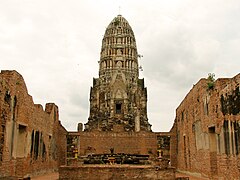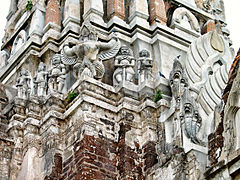Wat Ratchaburana (Ayutthaya)
The Wat Ratchaburana (also Wat Ratburana , Thai วัด ราช บุรณะ พระนครศรีอยุธยา , read: [wát râːt buː-rá-ná prá-ná-kon sĭ à-yú-tá-yaː] ) is a Buddhist temple complex ( Wat ) in the Ayutthaya Historical Park , Central Thailand .
location
Wat Ratchaburana is on the edge of the center of the old town of Ayutthaya, west of the Lopburi River . To the south opposite is Wat Mahathat Ayutthaya on Naresuan Street , both of which form a twin temple , so to speak.
Building history
According to most versions of the " Royal Chronicles of Ayutthaya ", Wat Ratchaburana was built in 1424 ("in the year of the dog 780 CS ") at the instigation of King Borommaracha II (r. 1424–1448) to the ashes of his older brothers Chao Ai Phraya and to take in Chao Yi Phraya, who had previously killed each other in an elephant duel for the throne "at the foot of the Pa-Than Bridge". The name of the temple can be translated as royal fulfillment . This version corresponds to the "official" historiography of Thailand, which is based on studies by Prince Damrong Rajanubhab .
The "Luang Prasoet version" of the Royal Chronicles, however, dates the duel between the two brothers to the year 786 CS, "a year of the dragon" (1430). The third brother, Prince Sam Phraya, was therefore crowned King Boromarajah. He had two chedis built at the site of the duel. In the same year he founded the monastery "Wat Ratchabun" ( Royal Merits ), which was apparently independent of the events that led to his coronation.
The penultimate king of Ayutthaya Uthumphon , who was taken hostage by the Burmese in 1767, writes in his chronicle that Wat Ratchaburana was founded by King Ekathotsarot (r. 1605-1610) “in the city southeast of the palace”.
Finally, there is the version of the "Inhabitants of the Old Capital" ( Khamhaikan Chao Krung Kao ) who were captured by the Burmese in 1767. This version describes the founding of seven great monasteries by King Boromakot (r. 1733–1758), one of which was called Wat Ratchaburana.
Attractions
The high prang of Wat Ratchaburana still has numerous decorations, such as Nagas , Garudas and other smaller figures in beautiful stucco work .
During the extensive restoration work initiated by the Thai government in 1957/58, historical valuables were found in a crypt in Prang, such as royal regalia made of gold and set with jewels , antique pieces of jewelery in excellent workmanship and several golden Buddha statues . You are now in the Chao Sam Phraya National Museum in Ayutthaya. Further research revealed a total of three rooms, three of which are decorated with wall paintings . They were used as offerings and were not originally intended for the public. The rooms were filled with thousands of neatly stacked votive tablets with images of Buddha from Thailand, India , Burma , Indonesia and Nepal on them. Among the votive tablets there are also three with Chinese inscriptions and a gold plaque with Chinese characters. There are also two gold pieces from Kashmir, three Buddha images from Sri Lanka , a stone Buddha from India and another from Nepal. This find shows the vastness of Ayutthaya's relationships in the 15th century.
Monument preservation
Wat Ratchaburana was badly affected by the flood disaster in autumn 2011, as the water in large parts of the Ayutthaya Historical Park was around 1 m high for several weeks. In December 2011 talks were held between the Department of Fine Arts and the German Embassy, whereby Wat Ratchaburana was selected as a "preservation object". A concept should be developed here as an example to preserve the fine stucco and plaster decorations. In 2012 the “German Wat Ratchaburana Safeguarding Project” (GRASP) was founded. Project partners are the Thai Department of Fine Arts and the Cologne University of Applied Sciences , Institute for Restoration and Conservation Science (CICS) under the direction of Hans Leisen . The project was funded by the Foreign Office and the UNESCO country office was also involved .
In three major campaigns, in summer 2012, in spring and in summer 2012, an extensive German team worked together with a team from the Ayutthaya Historical Park Office . All the conservation steps were precisely described and translated into Thai. The project duration was limited to December 2013. During this time, work on the entrance building and the south-east side of the Prang could be completed. The preservation of the southwest side and emergency safety measures have been prepared so that the Thai employees can carry out further work independently if no further funds are approved by the Foreign Office.
Individual evidence
- ^ Peter Skilling: Past Lives of the Buddha: Wat Si Chum - Art, Architecture and Inscriptions . Antique Collectors Club 2008. ISBN 9749863453
- ↑ http://www.aasianst.org/absts/2005abst/Southeast/se-141.htm
- ↑ http://erhalte.es/german-wat-ratchaburana-safeguarding-project/
- ↑ Prof. Leisen has already achieved great success with the German Apsara Conservation Project in Angkor since 1995.
- ↑ Source: Esther von Plehwe-Leisen: Stucco decorations in the old royal city of Ayutthaya . In: Thailand-Rundschau of the German-Thai Society , No. 3 - 2013, ISSN 0934-8824
literature
- HRH Prince Damrong Rajanubhab: A History Of Buddhist Monuments In Siam . Bangkok 1929, reprint by The Siam Society , Bangkok 1962, oh. ISBN
- Piriya Krairiksh: A Revised Dating of Ayudhya Architecture (I) . Article in Journal of the Siam Society, Vol. 80 Part 1, Bangkok 1992, ISSN 0857-7099 , online [1] (PDF, last accessed on October 31, 2012; 2.5 MB).
- Richard D. Cushman (David K. Wyatt Ed.): The Royal Chronicles Of Ayutthaya . The Siam Society, Bangkok 2000, ISBN 974-8298-48-5
- Clarence Aasen: Architecture of Siam: A Cultural History and Interpretation . Oxford: Oxford University Press 1998. ISBN 983-56-0027-9 .
Web links
- http://www.orientalarchitecture.com/ayutthaya/RATCHABURANA.htm Description and photos of Wat Ratchaburana
- Photos of the finds from the Prang (Chao Sam Phraya National Museum)
Coordinates: 14 ° 21 ′ 31 ″ N , 100 ° 34 ′ 2 ″ E






